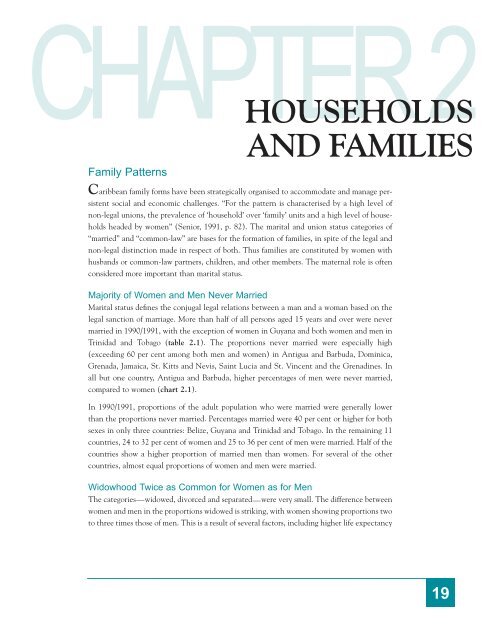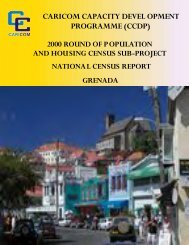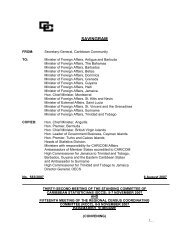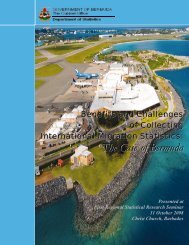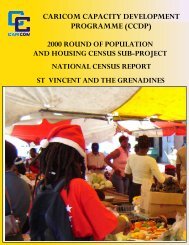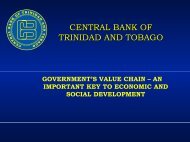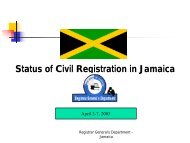Women and Men in the Caribbean Community
Facts and Figures, 1980-2001 - CARICOM Statistics
Facts and Figures, 1980-2001 - CARICOM Statistics
You also want an ePaper? Increase the reach of your titles
YUMPU automatically turns print PDFs into web optimized ePapers that Google loves.
CHAPTER 2HOUSEHOLDSAND FAMILIESFamily Patterns<strong>Caribbean</strong> family forms have been strategically organised to accommodate <strong>and</strong> manage persistentsocial <strong>and</strong> economic challenges. “For <strong>the</strong> pattern is characterised by a high level ofnon-legal unions, <strong>the</strong> prevalence of ‘household’ over ‘family’ units <strong>and</strong> a high level of householdsheaded by women” (Senior, 1991, p. 82). The marital <strong>and</strong> union status categories of“married” <strong>and</strong> “common-law” are bases for <strong>the</strong> formation of families, <strong>in</strong> spite of <strong>the</strong> legal <strong>and</strong>non-legal dist<strong>in</strong>ction made <strong>in</strong> respect of both. Thus families are constituted by women withhusb<strong>and</strong>s or common-law partners, children, <strong>and</strong> o<strong>the</strong>r members. The maternal role is oftenconsidered more important than marital status.Majority of <strong>Women</strong> <strong>and</strong> <strong>Men</strong> Never MarriedMarital status def<strong>in</strong>es <strong>the</strong> conjugal legal relations between a man <strong>and</strong> a woman based on <strong>the</strong>legal sanction of marriage. More than half of all persons aged 15 years <strong>and</strong> over were nevermarried <strong>in</strong> 1990/1991, with <strong>the</strong> exception of women <strong>in</strong> Guyana <strong>and</strong> both women <strong>and</strong> men <strong>in</strong>Tr<strong>in</strong>idad <strong>and</strong> Tobago (table 2.1). The proportions never married were especially high(exceed<strong>in</strong>g 60 per cent among both men <strong>and</strong> women) <strong>in</strong> Antigua <strong>and</strong> Barbuda, Dom<strong>in</strong>ica,Grenada, Jamaica, St. Kitts <strong>and</strong> Nevis, Sa<strong>in</strong>t Lucia <strong>and</strong> St. V<strong>in</strong>cent <strong>and</strong> <strong>the</strong> Grenad<strong>in</strong>es. Inall but one country, Antigua <strong>and</strong> Barbuda, higher percentages of men were never married,compared to women (chart 2.1).In 1990/1991, proportions of <strong>the</strong> adult population who were married were generally lowerthan <strong>the</strong> proportions never married. Percentages married were 40 per cent or higher for bothsexes <strong>in</strong> only three countries: Belize, Guyana <strong>and</strong> Tr<strong>in</strong>idad <strong>and</strong> Tobago. In <strong>the</strong> rema<strong>in</strong><strong>in</strong>g 11countries, 24 to 32 per cent of women <strong>and</strong> 25 to 36 per cent of men were married. Half of <strong>the</strong>countries show a higher proportion of married men than women. For several of <strong>the</strong> o<strong>the</strong>rcountries, almost equal proportions of women <strong>and</strong> men were married.Widowhood Twice as Common for <strong>Women</strong> as for <strong>Men</strong>The categories—widowed, divorced <strong>and</strong> separated—were very small. The difference betweenwomen <strong>and</strong> men <strong>in</strong> <strong>the</strong> proportions widowed is strik<strong>in</strong>g, with women show<strong>in</strong>g proportions twoto three times those of men. This is a result of several factors, <strong>in</strong>clud<strong>in</strong>g higher life expectancy19


